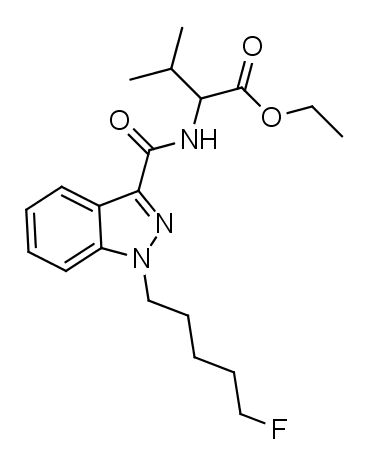Summary
5F-EMB-PINACA, alternatively recognized as EMB-5F-PINACA by the EMCCDA’s nomenclature for synthetic cannabinoids and also referred to as 5F-AEB is a member of the indazole-3-carboxamide family of synthetic cannabinoids. This compound has been marketed on the internet as a designer drug.
In April 2015, the EMCDDA initially documented its existence as part of a seizure in Sweden, where 149 grams of white powder were confiscated.
| Identifiers | |
|---|---|
| IUPAC name | |
| CAS Number | None |
|---|---|
| ChemSpider | 58191441 |
| UNII | 64OSW0N4YB |
| Chemical and physical data | |
| Formula | C20H28FN3O3 |
| Molar mass | 377.460 g·mol−1 |

Legal status
5F-EMB-PINACA is illegal in Sweden as of 26. January 2016.
FAQ
1. What is 5F-EMB-PINACA?
- 5F-EMB-PINACA is a synthetic cannabinoid belonging to the indazole-3-carboxamide family. It is often referred to as EMB-5F-PINACA or 5F-AEB.
2. How is 5F-EMB-PINACA used?
- It is primarily consumed as a recreational drug, and it is commonly smoked or vaporized for its psychoactive effects.
3. What are the effects of 5F-EMB-PINACA?
- The effects of 5F-EMB-PINACA can include altered perception, relaxation, and a feeling of euphoria. However, it can also produce adverse effects like anxiety, paranoia, and increased heart rate.
4. Is 5F-EMB-PINACA legal?
- The legal status of 5F-EMB-PINACA varies by country and jurisdiction. It has been banned in several places due to safety concerns.
5. What are the risks associated with 5F-EMB-PINACA use?
- Using synthetic cannabinoids like 5F-EMB-PINACA can be associated with serious health risks, including addiction, unpredictable side effects, and potential long-term harm to mental and physical health.
6. How was 5F-EMB-PINACA discovered?
- The compound was initially reported by the European Monitoring Centre for Drugs and Drug Addiction (EMCDDA) when 149 grams of white powder containing 5F-EMB-PINACA were seized in Sweden in April 2015.
7. Can 5F-EMB-PINACA be detected in drug tests?
- Yes, 5F-EMB-PINACA can often be detected in standard drug tests, as it is chemically similar to THC, the psychoactive component of cannabis.
8. Is 5F-EMB-PINACA safe to use?
- No, it is not considered safe for consumption. The use of synthetic cannabinoids carries significant risks due to their unpredictable nature and potential for adverse reactions.
9. Where can I find more information about 5F-EMB-PINACA?
- For further information and guidance regarding 5F-EMB-PINACA, it is recommended to consult with local health authorities, substance abuse professionals, or drug education resources.
References
- In a publication by Pulver B, Fischmann S, Gallegos A, and Christie R in Drug Test Analysis (2023), the EMCDDA framework and practical guidance for naming synthetic cannabinoids is discussed in detail, shedding light on the nomenclature intricacies in this field. This publication delves into the naming conventions of synthetic cannabinoids, providing valuable insights. [Reference: Pulver B, Fischmann S, Gallegos A, Christie R. EMCDDA framework and practical guidance for naming synthetic cannabinoids. Drug Test Anal. 2023;15(3): 255‐276. doi:10.1002/dta.3403]
- “5F-AEB” was referenced by Cayman Chemical, a significant player in the chemical research industry. This compound, also known as 5F-EMB-PINACA, is a part of the synthetic cannabinoid family. [Reference: Cayman Chemical. Retrieved 10 August 2015]
- The United Nations Office on Drugs and Crime (UNODC) documented fifteen novel synthetic cannabinoids reported to UNODC EWA in 2015. This organization plays a vital role in monitoring and reporting on emerging psychoactive substances. [Reference: “UNODC EWA: Fifteen novel synthetic cannabinoids reported to UNODC EWA since the beginning of the year”. United Nations Office on Drugs and Crime (UNODC). Retrieved 10 August 2015]
- “EWS_EU / AT: checkit; neue psychoakt. Subst” provides information on new psychoactive substances and falls under the auspices of Gesundheit Österreich GmbH. Their role in tracking and reporting on such substances contributes to public health efforts. [Reference: “EWS_EU / AT: checkit; neue psychoakt. Subst”. Gesundheit Österreich GmbH. Retrieved 10 August 2015]
- In November 2015, Folkhälsomyndigheten, a Swedish authority, addressed 31 new substances that could potentially be classified as narcotics or pose a health hazard. This highlights their ongoing commitment to public safety. [Reference: “31 nya ämnen kan klassas som narkotika eller hälsofarlig vara” (in Swedish). Folkhälsomyndigheten. November 2015]